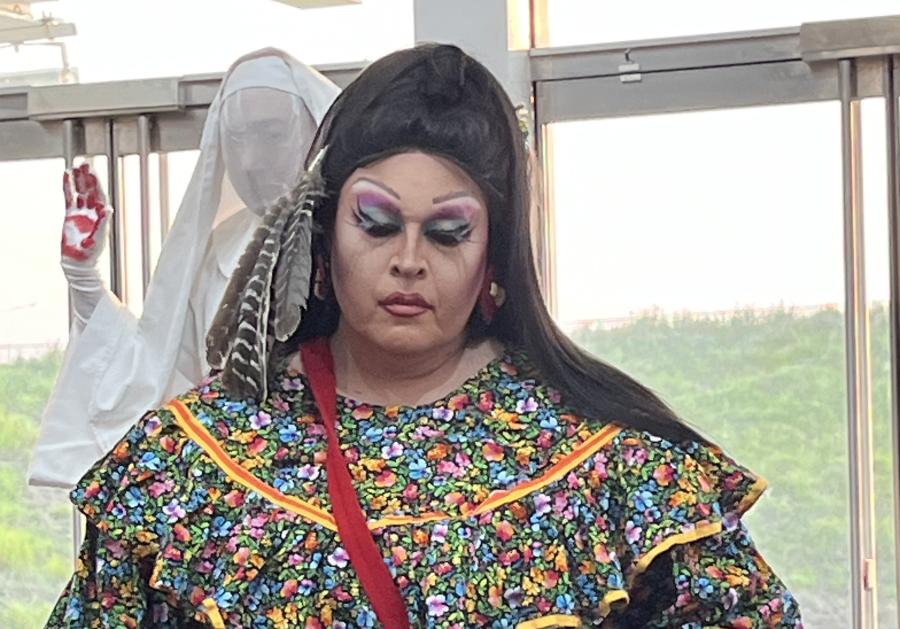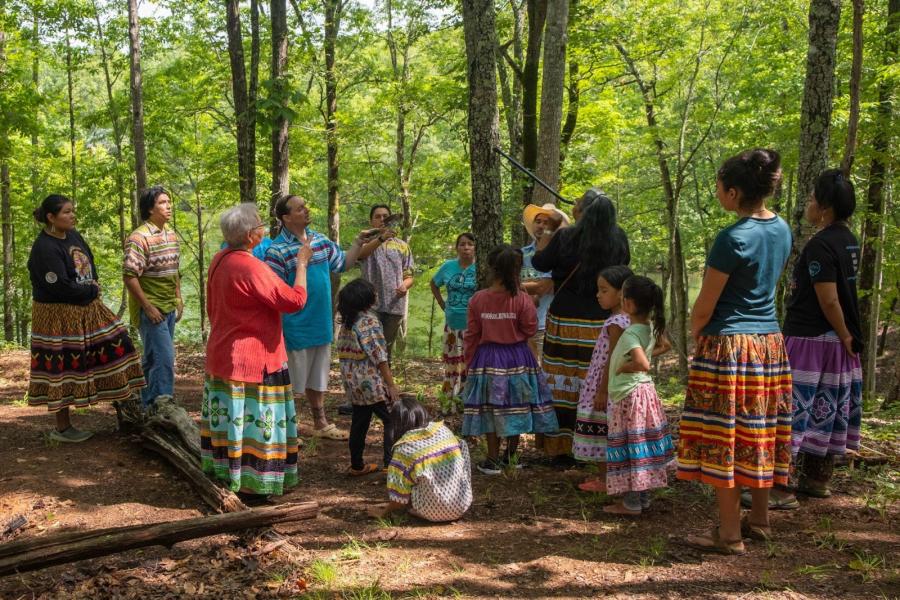The popularity of Navajo rug designs has allowed some fair trade businesses to thrive while Navajo weavers suffer.
Ninety percent of indigenous peoples living in the southwestern United States depend on crafts as their principal or secondary source of income. Yet, of the $1 billion worth of American Indian arts and crafts sold annually in the United States, more than 50 percent is “fake,” according to Andy Abeita of the Council for Indigenous Arts and Culture.
Thousands of Diné (Navajo) weavers face formidable competition as their historic patterns, increasingly reproduced abroad, are imported and sold via sophisticated marketing schemes, including hundreds of websites on the internet. A Google search for “Navajo rugs” returned more than 140,000 hits. Close inspection of the first 100 sites reveals entrepreneurs either reselling historic Navajo textiles or dozens of firms advertising “Navajo-inspired” rugs.
Many Navajo designs are elaborations on patterns found in Navajo baskets and petroglyphs scattered across the reservation. Navajo weavers say that any design woven by a Navajo weaver within the four sacred mountains of the Navajo Nation is sacred. The plants, animals, rocks, mountains, and other geographical elements of the region, as well as the sheep wool, dye plants, and pinon pine used to build the weaving loom, were given to the Navajo by their Holy People.
Copy or imitation Navajo weaving is currently produced in Guatemala, Peru, Hong Kong, India, Pakistan, Japan, Egypt, Hungary, Romania, northern Thailand and, in particular, Oaxaca, Mexico. In Oaxaca, Zapotec designs woven prior to the 1970s were similar to Navajo designs—tapestry weaving lends itself to creating geometric designs because of the relationship of the loom’s vertical warps to horizontal wefts—but contained distinct Zapotec elements that were related to designs carved into stone on Zapotec buildings. Outside entrepreneurs have since brokered the appropriation of Navajo designs by Zapotec weavers. Although imports bearing Navajo designs must be labeled noting their country of origin, the lack of communal copyright protection for historic patterns has seriously eroded the volume of thousands of Navajo weavers’ sales. During interviews over the past decade, Navajo weavers have said that their incomes have declined at least 40 percent. Only a handful of the 25,000 weavers interviewed make an adequate living.
More than 200,000 Navajo reside in the Navajo Nation (Diné Bikeyah), which encompasses more than 27,000 square miles in Arizona, New Mexico, and Utah. Significant portions are remote and isolated and more than 80 percent of the roads are unpaved. Over half the population lives below the poverty level, unemployment hovers around 50 percent, and per capita income is 20 percent of the U.S. average. Unlike the Canadian Arctic, where government-subsidized cooperatives enable indigenous artisans to make a living, no comparable reservation-wide weavers’ associations exist. A few regional nonprofits market weavings (and Navajo-raised wool and mohair) with varying degrees of success. The number of retailers in Arizona and New Mexico that feature authentic Navajo weaving has declined dramatically over the past 20 years, indirectly proportional to the rise in the number of stores selling knock-offs. Markups as high as 500 percent inhibit strong sales, while most weavers are paid much lower prices. A curator from Ganado trading post tracked sales at the monthly Crownpoint, New Mexico, auction between 1992 and 2001. The average sale was $250 for a rug, and the weaver had to remit 15 percent to the auction organizers. These rugs often were resold by retailers. Under pressure to buy food or gas, some weavers say, “I gave my weaving away today,” meaning they sold it to a local trading post for what they considered much less than its value.
Alternative trade organizations (ATOs) are deeply committed to supporting people- centered development. As exporters and retailers, they work directly with artisan groups to ensure makers are paid a fair wage and have safe and healthy working conditions. They offer technical and business expertise and monitor product quality. Some ATOs use design consultants to ensure that artisans produce marketable articles. Because of the popularity of the “Santa Fe style” or “southwestern” look, artisan groups affiliated with or collaborating with ATOs frequently use Navajo patterns. Peace Corps workers introduced Navajo designs to South American weavers during the 1970s, and a number of fair trade organizations in North America currently market knock-offs woven in Mexico and Peru. In April 1999, an associate with the alternative trade organization SERRV International admitted that the organization acquired textiles from Peruvian weavers bearing Navajo designs. Another fair trade retailer has Zapotec weavers copy Navajo patterns from the Smithsonian’s collection. During October 2002, I contacted two dozen ATOs and queried whether they carried textiles using Navajo patterns. Eighteen had the merchandise I requested.
Navajo weavers have faced appropriation of their designs for over a century, longer than many Third World peoples whose intellectual and cultural property rights are now being addressed by international organizations such as the World Intellectual Property Organization. Anthropologists and political economists working with weavers in Latin America and elsewhere neglected to consider what negative repercussions pattern appropriation would have on contemporary Navajo weavers. They were likely lulled into a sense of complacency by inadequately contextualized literature on Diné weavers. Until recently, anthropologists and popular writers have convinced the public that Navajo weavers’ patterns are derivative. Over 60 years ago, ethnographer Gladys Reichard implicitly sanctioned the categorization of functional textiles as “non-sacred” craft commodities because, she said, commercialization by traders not only submerged any sacred associations, but also obliterated a distinctly Navajo “aesthetic.” Labeling weaving as non-sacred not only provided a justification for collectors’ and dealers’ actions, but opened the doors to wholesale appropriation of Navajo patterns by entrepreneurs anxious to cash in. Textile scholar Kate Peck Kent wrote in 1985 in Navajo Weaving: Three Centuries of Change: “…rugs woven in this [20th] century will not tell us anything about Navajo personality or values because Anglo traders and markets have influenced Navajo weavers so much that any meanings or aesthetic styles which may have existed in early weavings were extinguished. ...The search for a distinctive Navajo aesthetic ends with the onset of the Rug period [in 1890]. When weavers ceased to manufacture blankets for their own use and turned to the production of rugs for sale to whites, they accepted Anglo American standards of taste.”
Unfortunately, such published statements by noted scholars helped recreate the power differentials that marginalized weavers in the first place. Because weaving was non-waged, political economists regarded it as non-productive. Cultural anthropologists told me they did not include the weavers in their studies because they were not interested in issues related to political economy. Prodigious production by thousands of women remained unanalyzed.
History and Consequences
During the 19th century, the textile industry was the third-largest industry in the United States, next to agriculture and steel. By 1900, U.S. cotton growers exported over 3 billion pounds of cotton annually. However, the country produced only 300 million pounds of wool, less than 50 percent of manufacturers’ annual requirements. Wool was a vital and strategic commodity; Great Britain and her colonies dominated world production, and prices were pegged weekly in Bradford, England.
Prior to the formation of the Navajo Reservation in 1868, the Navajo wearing blanket served as “the mother from which all external Navajo [inter-tribal] trade ... developed,” wrote Richard F. Van Valkenburg and John McPhee in 1974 in A Short History of the Navajo People. As successful pastoralists and horticulturalists, Navajo were christened “the lords of the desert” by the U.S. cavalry. Blankets were frequently used as the unit of exchange by which other goods were measured. By 1890, Diné were the only domestic growers who raised churros, coarse-woolen sheep, for rug wool. They sold the wool through government-licensed traders, but were able to produce less than 5 million pounds annually, a fraction of manufacturers’ needs. Consequently, companies lobbied the U.S. Congress and all duties were removed from coarse wools purchased from more than 25 countries. By 1900, the U.S. imported 125 million pounds of carpet wool duty-free. Fifty million pounds came from China alone—more wool than the U.S. produces today.
Because of free trade in carpet wools, reservation traders faced difficulties marketing the Diné wool crop. Between 1880 and 1920, the population of the Navajo Nation grew by 50 percent, but textile production jumped 800 percent. Annual reports written by U.S. government agents to the Navajo and sent to the Commissioner ofIndian Affairs in Washington, D.C., during that period reveal how government officials treated weaving as an extension of the livestock industry—an alternative means to market the annual wool clip. Trader Lorenzo Hubbell, christened the czar of Navajo trade and father of the Navajo rug, shipped over 200 tons of handspun textiles from Ganado on the Navajo Reservation, his key post between 1893 and 1913, to customers like the Fred Harvey Company. Weavers not only lost control of the marketing of their textiles to traders, but they also lost the market to Pendleton and other trade blanket manufacturers.
Haphazard attempts to improve the fleeces of Navajo flocks by cross-breeding culminated in a failed development policy. By 1930, women’s textile production soared to $1 million—one-third of the Navajo Nation’s annual revenue. Until the 1960s, nearly all textiles were acquired from weavers by weight, a practice that undervalued their work. Most earned only $6 to $8 per rug. Such remarkable production haunts contemporary producers. Since 1970, more than $50 million worth of pre-1950 textiles has changed hands. Dealers who broker 19th-century textiles fetch record prices at international auctions such as Sotheby’s. Narratives of nostalgia related to Navajo trading history continue to dominate the academic literature, and the historic textiles receive far more attention in academic publications than the predicaments the weavers face today.
Worried Weavers
When Bonnie Benally Yazzie, manager of the Eastern Navajo Weavers’ Association, received an El Paso Saddle Blanket catalog in November 2003 depicting hundreds of Navajo rug designs, she sent me an urgent e-mail: “I got the packet in the mail today about the knock-offs. I took the pages to the [Crownpoint] rug auction this evening and showed them to all of the weavers and they were upset. I told them to contact their council delegates so the Navajo Nation can take a stand against knock-offs or at least do something about it to protect the weavers and their rugs/designs. I hope to keep the momentum going. The cost of xeroxing will be covered by the [nonprofit organization] DNA Legal Services due to lack of funds. The weavers want to know who is weaving these rugs, which country they are from and if the company has copyrights to the rugs?”
Bonnie’s urgent e-mail reflects how unauthorized appropriation of Navajo designs harms Navajo weavers. Bonnie also mentioned that attendance at the monthly auction was dropping. Fewer than 100 bidders attended the August 2003 event. Prices were low and weavings sometimes failed to sell at the opening bid.
When documenting the creolization of expressive forms through globalization, anthropologists have unwittingly sanctioned processes by which cultural commodities are removed from their social matrix and marketed. Zapotec weavers have admitted they are tired of weaving Navajo designs. They said they wish to return to those of their own heritage so they can strengthen their ethnicity and express their identity. But because the southwestern look retains its popularity, entrepreneurs face little difficulty in having Navajo designs woven elsewhere.
Anthropologists have the ability to help Navajo weavers by bringing discussion of these contemporary problems into the academic realm. Fair traders can help by marketing cultural diversity and encouraging weavers to move away from the Navajo patterns and use their own designs in their work. The benefits of each weaver’s unique contributions must be recognized if fair trade rug traders want to improve, not imperil, the livelihoods of producers.
Kathy M’Closkey is an anthropologist and author of Swept Under the Rug: a Hidden History of Navajo Weaving, published by the University of New Mexico Press. The book was awarded “Outstanding Academic Title” by the American Academic Library Association journal Choice. M’Closkey is an adjunct associate professor in the Department of Sociology and Anthropology at the University of Windsor, Ontario, Canada. She is research director of the forthcoming documentary Swept Under the Rug: Navajo Weavers, Reservation Traders and Free Trade, in collaboration with Trickster Films of Austin, Texas.
References and further reading:
Abeita, A. (1999). Protection Laws. Collecting Authentic Indian Arts and Crafts. Council for Indigenous Arts and Culture. Summertown, Tenn: Book Publishing. Pp 109-118.
Clifford, J. (1988). The Predicament of Culture. Cambridge, Masachusetts: Harvard University Press.
Kent, K.P. (1985). Navajo Weaving: Three Centuries of Change. Santa Fe: School of American Research Press.
Stanton, A. (1999). Woven By History. Native Peoples, 13:1, pp 38-42.
Van Valkenburg, R. F. & McPhee, J. (1974). A Short History of the Navajo People. New York: Garland.
Weiss, L. (1984). The Development of Capitalism in the Navajo Nation: a Political Economy History. MEP Publications #15, Studies in Marxism.
Wheat, J. B. (2004). Blanket Weaving in the Southwest. Hedlund, Ann, Ed. Tucson, Arizona: University of Arizona Press.
Whitaker, K. & Hart, S. (2002). Southwest Textiles: Weavings of the Pueblo and Navajo. Seattle, Washington: University of Washington Press.
Wood, W. W. (2001). Rapport is Overrated: Southwestern Ethnic Art Dealers and Ethnographers in the “Field.” Qualitative Inquiry, 7:4, pp 484-503.
Wood, W. W. (2001). The “Invasion” of Zapotec Textiles: Indian Art “Made in Mexico” and the Indian Arts and Crafts Act. In Approaching Textiles, Varying Viewpoints. Textile Society of America Proceedings. Earleville, Maryland: TSA. Pp 272-81.



